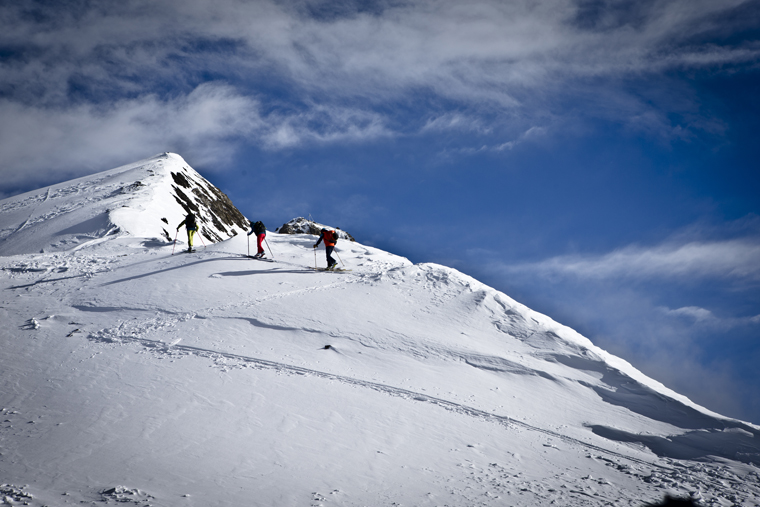How to make a skin track


You are skinning like a pro, and whipping out the kick turns like you were born to do them (well, almost). Now the adventure begins – it is time to make your own track and go in search of that virgin powder you’ve spent all month salivating over.

If you are on a popular ski tour there will usually be a track to follow, so you won’t need to worry about where to go. While you are following other people’s tracks think: what is good about this track? And what is bad about it? Is it too steep, and therefore hard to skin? Is it too shallow, so it doesn’t feel like you’re gaining any height? Does the angle allow a relaxed pace? Or do I have to change stride length constantly? Are the corners in good places? Do I have to kick turn where a change of direction in a different place would be more comfortable, and hence quicker and safer?
To those questions we have to add safety questions: does the track avoid potential avalanche hazards? Does it keep me away from ice fall or rock fall danger? Am I clear of crevasse danger? These factors need to be fed into your track planning.
Having analysed other people’s tracks you can begin to develop some ideas about what makes a good track yourself. Then comes the fun bit – planning and setting your own track…
The art of track setting is your opportunity to scribe your mark on the landscape. A good track uses all the subtleties in the landscape to allow you to flow uphill in a safe and efficient way.
When looking at the landscape to decide where you are going to put a track, you are trying to choose the safest and most efficient route through that piece of ground.
If we put safety considerations to one side at the moment and just think about the line of ascent, what are we looking for?
Try to choose low-angled terrain to give you the easiest skinning track across a piece of ground. It is always quicker if you choose a line that keeps you skinning at a smooth, consistent pace, rather than setting a steep, direct line where you need to use your heel raisers and work really hard. By choosing the low-angled ground as you work your way through the terrain, you can avoid making too many kick turns and skinning on steep, more awkward ground. By the same token you don’t want your route to be too circuitous or you will add too much distance and time.
Looking for the low-angled terrain to skin up doesn’t mean skinning on the flat, but rather choosing the lowest-angled ground within a piece of terrain, so you still may be on what feels like steep ground but with steeper ground around you.
If your goal isn’t to climb a particular mound or summit, can you contour round it? Imagine you are heading for a col: you want to weave your way through the terrain climbing steadily but never having to lose any height. If you need to make any changes in direction, look for spots where you can step turn instead of kick turn, as this uses less energy.
At times kick turns are unavoidable, and when the terrain dictates you will have to make the classic zigzag track to climb a piece of ground. If you are forced into this style of track you still need to concentrate on getting the track angle right, to keep that efficient flow and try to minimise the number of kick turns.
Think about where you are going to make the kick turns; they will be easier on the lower-angled sections. Be aware of what is underneath you and the consequences of a slip mid-turn for yourself or other members of your team. If the kick turn has to be in an exposed place think about cutting a platform with your ice axe or shovel. When making a track I will make my track horizontal just before the kick turn to give a better platform to turn on.
The added benefit of choosing low-angled terrain is that you are less likely to stray onto avalanche-prone slopes. You are pretty unlikely to trigger an avalanche on a slope shallower than 30°. It is these slopes that are easiest to skin on. However, if the slope steepens above 30° make sure all your avalanche antenna are out. I know more guides who have been avalanched skinning up than skiing down on this sort of angle.